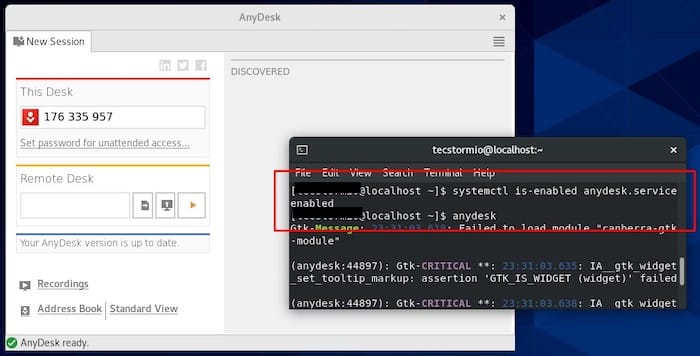How To Install AnyDesk on Fedora 40

In today’s interconnected world, remote access to computers has become increasingly essential. Whether you’re a system administrator managing multiple machines or a remote worker accessing your office computer from home, having a reliable remote desktop solution is crucial. AnyDesk, a popular remote desktop application, offers a seamless way to connect to and control computers from afar. This guide will walk you through the process of installing AnyDesk on Fedora 40, ensuring you have the tools you need for efficient remote access.
Fedora, known for its cutting-edge features and robust security, provides an excellent platform for running AnyDesk. By following this step-by-step tutorial, you’ll be able to set up AnyDesk on your Fedora 40 system quickly and easily. We’ll explore multiple installation methods, configuration options, and troubleshooting tips to ensure a smooth experience.
Prerequisites
Before we dive into the installation process, let’s ensure you have everything you need to successfully install AnyDesk on your Fedora 40 system:
System Requirements:
- A computer running Fedora 40
- Sudo or root access to the system
- At least 100 MB of free disk space
Network Requirements:
- A stable internet connection for downloading packages
- Outbound access on ports 80 and 443 for AnyDesk connectivity
User Requirements:
- Basic familiarity with Linux terminal commands
- Comfort with using the command line interface (CLI) or graphical user interface (GUI)
Ensuring these prerequisites are met will pave the way for a smooth installation process. Now, let’s explore the different methods available for installing AnyDesk on Fedora 40.
Methods of Installation
There are two primary methods to install AnyDesk on Fedora 40:
1. Command Line Interface (CLI) Method: This approach involves using terminal commands to add the AnyDesk repository and install the software. It’s preferred by advanced users and system administrators for its efficiency and scriptability.
2. Graphical User Interface (GUI) Method: This method uses Fedora’s built-in software installer to install AnyDesk from a downloaded RPM package. It’s more intuitive for users who prefer a point-and-click interface.
We’ll cover both methods in detail, allowing you to choose the one that best suits your comfort level and needs.
Method 1: Installing AnyDesk via CLI
The command line method offers precise control over the installation process. Follow these steps to install AnyDesk using the terminal:
Step 1: Update the System
Before installing any new software, it’s crucial to ensure your system is up to date. This helps prevent potential conflicts and ensures you have the latest security patches. Open your terminal and run the following command:
sudo dnf update -yThis command updates all installed packages to their latest versions. The ‘-y’ flag automatically answers “yes” to any prompts, streamlining the update process.
Step 2: Add AnyDesk Repository
AnyDesk isn’t included in Fedora’s default repositories, so we need to add the official AnyDesk repository. This ensures we get the latest version directly from the source. Use the following command to create and populate the repository file:
sudo tee /etc/yum.repos.d/AnyDesk-Fedora.repo <This command creates a new file named ‘AnyDesk-Fedora.repo’ in the ‘/etc/yum.repos.d/’ directory, which is where Fedora stores repository information. The file contains the necessary details for DNF (Fedora’s package manager) to locate and download AnyDesk packages.
Step 3: Install AnyDesk
With the repository added, we can now install AnyDesk. First, refresh the package cache to include the new repository:
sudo dnf makecacheThen, install AnyDesk using the following command:
sudo dnf install anydeskDNF will calculate dependencies and prompt you to confirm the installation. Type ‘y’ and press Enter to proceed.
Step 4: Verify Installation
After the installation is completed, it’s good practice to verify that AnyDesk was installed correctly. You can do this by checking the package information:
rpm -qi anydeskThis command displays detailed information about the installed AnyDesk package, including its version and installation date.
Step 5: Enable and Start AnyDesk Service
To ensure AnyDesk starts automatically with your system and is running, use these commands:
sudo systemctl enable anydesk.service
sudo systemctl start anydesk.serviceThe first command enables the AnyDesk service to start on boot, while the second starts it immediately.
Method 2: Installing AnyDesk via GUI
For those who prefer a graphical approach, installing AnyDesk through Fedora’s software installer is straightforward:
Step 1: Download AnyDesk RPM Package
1. Open your web browser and navigate to the official AnyDesk website.
2. Scroll down to find the Fedora package and click on the download button for the RPM package.
3. Choose a location to save the file, typically the Downloads folder.
Step 2: Install RPM Package via Software Installer
1. Once the download is complete, navigate to your Downloads folder using the file manager.
2. Right-click on the AnyDesk RPM file you just downloaded.
3. Select “Open with Software Install” from the context menu.
4. The Software Install application will open, displaying information about AnyDesk.
5. Click the “Install” button.
6. You may be prompted to enter your administrator password to authorize the installation.
7. Wait for the installation to complete.
After installation, you can find AnyDesk in your applications menu or launch it from the terminal by typing ‘anydesk’.

Post-Installation Configuration
Once AnyDesk is installed, there are a few additional steps to optimize its performance and security:
Firewall Configuration
Fedora’s default firewall might block AnyDesk connections. To allow AnyDesk through the firewall, use these commands:
sudo firewall-cmd --zone=public --add-service=anydesk --permanent
sudo firewall-cmd --reloadThese commands add an exception for AnyDesk in the firewall rules and reload the firewall to apply the changes.
Setting Up AnyDesk
1. Launch AnyDesk from your applications menu or by typing ‘anydesk’ in the terminal.
2. When AnyDesk opens for the first time, it will display your AnyDesk address – a unique 9-digit number others can use to connect to your computer.
3. Click on “Set password for unattended access” to create a password. This allows you to access your computer remotely without someone needing to accept the connection manually.
4. Explore the settings menu to customize AnyDesk according to your preferences. You can adjust privacy settings, configure audio options, and set up custom shortcuts.
Troubleshooting Common Issues
While installing and using AnyDesk on Fedora 40 is generally smooth, you might encounter some issues. Here are solutions to common problems:
Dependency Issues
If you encounter dependency errors during installation, try the following:
1. Update your system again: sudo dnf update
2. Install any missing dependencies manually. For example: sudo dnf install [package-name]
3. If the issue persists, try cleaning the DNF cache and retrying the installation:
sudo dnf clean all
sudo dnf makecache
sudo dnf install anydeskService Start Failures
If the AnyDesk service fails to start, follow these steps:
1. Check the service status: sudo systemctl status anydesk.service
2. Look for any error messages in the output.
3. Ensure all dependencies are installed: sudo dnf install gtkglext-libs
4. Restart the service: sudo systemctl restart anydesk.service
If problems persist, consulting the AnyDesk logs can provide more insight:
journalctl -u anydesk.serviceCongratulations! You have successfully installed AnyDesk. Thanks for using this tutorial for installing the AnyDesk remote desktop software on Fedora 40 system. For additional help or useful information, we recommend you check the official AnyDesk website.